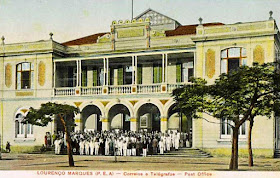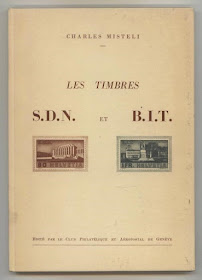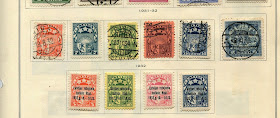1921 Scott 40 6m slate & buff
"Poczobut Astronomical Observatory"
Into the Deep BlueClearly, one of the more obscure stamp issuing entities for WW collectors is Central Lithuania, which existed on the stamp scene between 1920 and 1922
One can learn more about the history by visiting.......
Original Blog Post & BB Checklist
Central Lithuania - Bud's Big Blue
https://en.wikipedia.org/wiki/Republic_of_Central_Lithuania
Central Lithuania
From Gerben van Gelder's Stamp World History
As one can see from Gerben's map, Central Lithuania was absorbed into Poland in 1922, but was split between Lithuania and the Soviet Union (Poland) in 1939.
And one can learn more by taking a look at the stamps...
And one can learn more by taking a look at the stamps...
A closer look
100 Fennigi = 1 Markka
1921 Scott 4 1m dark brown "Coat of Arms"
Perf 11 1/2
The first Central Lithuania issue of 1920-21 consisted of six typographic stamps (both Perf 11 1/2 and Imperf). The design clearly show where their sentiments lay: to Poland. Note the "Poczta" inscription?
CV is <$1, with used slightly higher in value.
I should mention that this issue (and many issues of Central Lithuania) can be found with color and paper shades.
I should also mention that most of the Central Lithuania stamp issues exist both perf and imperf.
During the Russo-Polish war, the territory was seized by Lithuania. But, under the leadership of Polish General Zeligowski, the territory was recaptured and occupied. During this time, the Central Lithuania stamps were issued. The territory then became part of Poland.
The next issue for Central Lithuania (November 23, 1920; Scott 13-22) consisted of Lithuanian stamps of 1919 that were surcharged in blue or black. I don't have any, and the higher values have been forged. CV is high ($40+-$1,000+).
CV is <$1, with used slightly higher in value.
I should mention that this issue (and many issues of Central Lithuania) can be found with color and paper shades.
I should also mention that most of the Central Lithuania stamp issues exist both perf and imperf.
During the Russo-Polish war, the territory was seized by Lithuania. But, under the leadership of Polish General Zeligowski, the territory was recaptured and occupied. During this time, the Central Lithuania stamps were issued. The territory then became part of Poland.
The next issue for Central Lithuania (November 23, 1920; Scott 13-22) consisted of Lithuanian stamps of 1919 that were surcharged in blue or black. I don't have any, and the higher values have been forged. CV is high ($40+-$1,000+).
1920 Scott 24 1m orange "Warrior"
Perf 11 1/2
The next issue of 1920 was lithographed, and had six pictorial and portrait stamps.
The designs are rather eye catching. The "Warrior" stamp (above) and the "Lithuanian Girl" ( see original blog post) are some of my favorites.
CV is <$1 to $3+, with used slightly higher.
The designs are rather eye catching. The "Warrior" stamp (above) and the "Lithuanian Girl" ( see original blog post) are some of my favorites.
CV is <$1 to $3+, with used slightly higher.
1920 Scott 26 4m gray green & buff
"Tower and Cathedral, Vilnius
Perf 11 1/2 & Imperf - Shades
The stamps for this issue can be found in various shades. And remember, most issues are both perforated and imperforated. Scott does not separate out the imperfs and they have same Scott numbers as the perforated examples.
A word to the wise: since Central Lithuania's stamps are mostly lithographed, they provide fertile grounds for forgeries.
Pay attention to perfs, as the forgeries often have different perfs than the genuines.
1920 Scott 27 6m rose & gray
"Rector's Insignia"
This is not a very attractive cancelled stamp, but I would rather have a real genuine cancelled stamp than a "philatelic used souvenir" (CTO and the like). But I suppose this too could be a "souvenir".
1921 Scott 36 2m rose & green, Perf 14
"St. Stanislas Cathedral, Vilnius
Perhaps the high point of Central Lithuania's stamp output design wise was the 1921 eight stamp eight design issue (Scott 35-42).
1921 Scott 41 10m red violet & buff, Perf 14
"Union of Lithuania and Poland"
The postmark date here is December 27, 1921, just before the election to determine Central Lithuania's fate (January, 8, 1922). Actually, with the 27,000 strong Polish occupation army in place, the Lithuanians in the territory refused to vote (considering it a sham), and naturally the election went for Poland. Lithuania refused to acknowledge (accept) the results of the election, and there was considerable tension between the two countries between WW I and WW II.
1921 Scott 42 20m black brown & buff
"Tadeusz Kosciuszko and Adam Mickiewicz"
I should mention that this issue can be found forged. The forgeries have Perf 11 1/2, while the genuines are Perf 14 or Imperf.
CV is <$1 to $1, with used a bit higher.
There is another 1921-22 six stamp six design issue (Scott 53-58) celebrating the opening of the National Parliament and the entry of General Zeligowski into Vilnius. CV is $3+ to $6 with used higher. Alas, I don't have any of these stamps.
CV is <$1 to $1, with used a bit higher.
There is another 1921-22 six stamp six design issue (Scott 53-58) celebrating the opening of the National Parliament and the entry of General Zeligowski into Vilnius. CV is $3+ to $6 with used higher. Alas, I don't have any of these stamps.
1921 Scott B1 25f + 2m red (Black Surcharge)
On Scott Nos 1-6
The 1921 six stamp semi-postal issue consists of regular issue Scott 1-6 surcharged in black or red. The surcharge reads "For Silesia, 2 marks". The stamps were intended to provide funds (in favor of Poland) for the Polish-German plebiscite of Upper Silesia. This time the Germans won.
CV is $1+ with used somewhat higher.
CV is $1+ with used somewhat higher.
1921 Scott B13 2m + 1 (m) claret
Scott 25 Surcharged, Imperf
In 1921, two stamps (Scott 25-26) were surcharged as shown for use as semi-postals.
CV is $1.
CV is $1.
1921 Scott B19 10m + 2m brown & yellow
"General Lucien Zeligowski"
1920-21 Scott J1 50f red violet, Perf 11 1/2
"University, Vilnius
Varro Tyler (Focus on Forgeries) has a page on this stamp: the 1920-21 50 fennigi postage due stamp. He states that the forgery, created by a photolithographic process, is impossible to distinguish from the crude original lithographc stamp except for some loss of detail.
However, the genuine is printed on white wove paper, Perf 11 1/2 or Imperf, and has multiple shades: here red violet or lilac red.
However, the genuine is printed on white wove paper, Perf 11 1/2 or Imperf, and has multiple shades: here red violet or lilac red.
1920-21 Scott J1 50f "purple" (shade) Perf 11 1/2
"University, Vilnius
This is a probable genuine on white wove paper with Perf 11 1/2 and a "purple" or lilac black shade.
1920-21 Scott J1 50f Imperf "University, Vilnius"
On Brown paper, Forgery
The forgery is found on "browned" paper, and either Perf 10 1/2 or Imperf.
1920-21 Scott J5 5m red violet, Perf 11 1/2
"Castle Ruins, Troki"
The 1920-21 postage due issue consists of six stamps and six designs.
1920-21 Scott J6 20m scarlet, Imperf
"St. Anne's Church, Vilnius"
CV for the issue is <$1 to $2, with used somewhat higher.
I guess one could say the stamp is so crude, it is almost modern in design. ;-)
I guess one could say the stamp is so crude, it is almost modern in design. ;-)
Deep Blue
1921 Issue in part (Scott 35-37)
Imperforate
In Deep Blue (Steiner), there are six pages for the 1920-22 stamps of Central Lithuania. All of the Scott major numbers have a space. I have a quadrilled page for the additional shades found for Scott 1-6.
1921 Scott B14 4m + 1m gray green & buff
Scott 26 Surcharged, Imperf
Out of the Blue
Long forgotten by most except for Polish-Lithuanian history buffs and WW stamp collectors, I would think an interesting collection could be formed if one wishes to sub-specialize. The CVs are modest indeed.
Note: I used Gerben van Gelder's map of Central Lithuania for this blog post. I had general permission from him to use his maps, and as his StampWorldHistory web site is not presently active, I have included it here.
Links
Comments appreciated!






























































